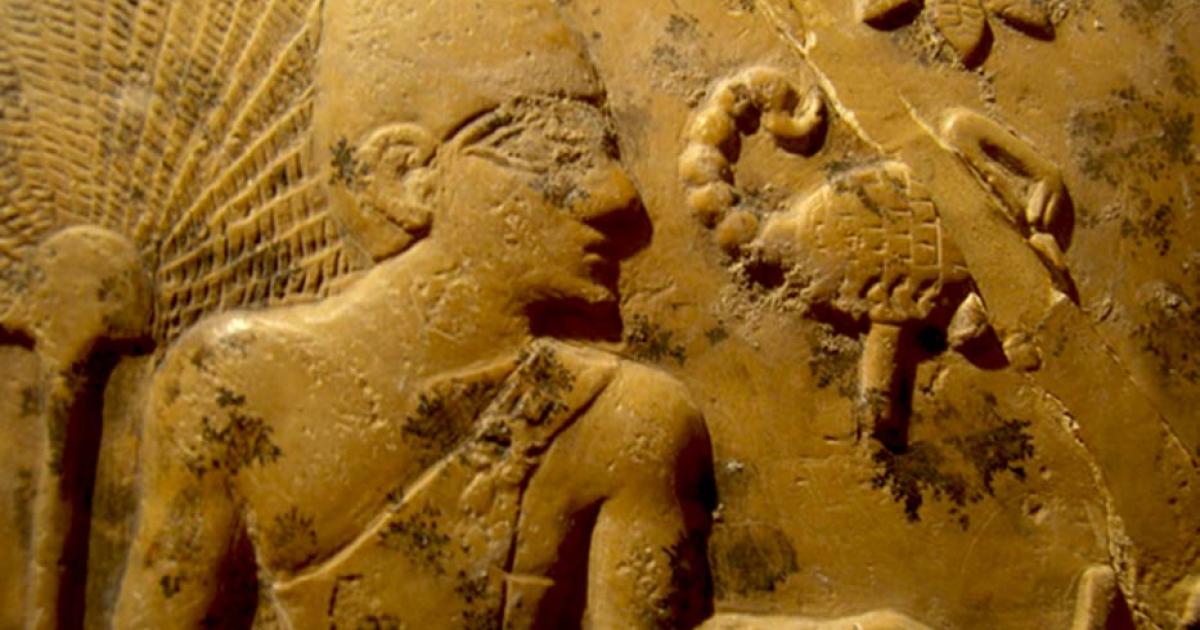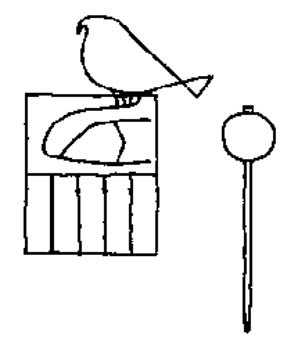
Searching for the Lost Footsteps of the Scorpion Kings
There were two Scorpion Kings in the pre-dynastic period of ancient Egypt. They were forgotten by most of the world until Dwayne Johnson played one of the rulers in the famous movie ‘The Scorpion King’. While the character depicted in the movie bears little resemblance to either of the actual pharaohs, the history of the real ancient Egyptian Scorpion Kings is even more thrilling and filled with mystery than the fictional portrayal.
The name ‘Scorpion’ probably comes from Serqet (also spelt Serket), the goddess of medicine, magic, nature, and animals. It is unknown when her cult first appeared but she was always depicted as a scorpion. It is not surprising that the scorpion would be revered in one way or another, as these small poisonous arachnids have lived among the sands of Egypt since well before the Egyptian civilization even began.

The Egyptian goddess Serqet with a scorpion on her head. (GFDL)
King Scorpion I
King Scorpion I lived in Thinis around 3200 BC, one or two centuries before the reign of the better-known Scorpion II. It is not known whether the two rulers were related to each other. Scorpion I ruled over Upper Egypt during the Naqada III period (the last phase of the Naqada culture of ancient Egyptian prehistory, dating from 3200 to 3000 BC). It is also uncertain when he started his reign and if he was a native or a foreigner.
- Magic and superstition in ancient Egypt
- Alcohol as medicine through the ages
- New Discovery Reveals Egyptians Brewed Beer 5,000 Years Ago in Israel
An example of the existence of the first Scorpion King in Egypt comes from a rock panel found at Gebel Tjauti (to the south-east of Abydos). Known as the Scorpion Tableau, the series of drawings suggest the victory of the Scorpion King over another ruler - possibly Naqada’s king.

1. The Gebel Tjauti tableau in the Theban Desert, possibly a record of a military expedition from about 3200 BC. 2. Inscriptions of King Scorpion I (Dynasty 00) (after Dreyer, 1998).
The tomb of the first Scorpion King is like a beautiful letter from the forgotten past. It is an ‘archaeological heaven’ for the researchers that have investigated the story of this king whose face was lost a long time ago.
King Scorpion I’s tomb is believed to be one of the oldest royal tombs in Abydos. An ivory scepter and small ivory plaques were discovered inside the tomb. His burial place also contained some of the earliest evidence for ancient wine – the chamber contained dozens of jars with wine residue, as well as grape seeds, skins, and dried pulp. Due to this organic material, it was possible to date the tomb back to c. 3150 BC.

Ivory scepter from the Abydos tomb of Scorpion I (“U-j”), a ruler of Upper Egypt that lived centuries before Egypt was unified. Even in these early times, the heqa scepter was a powerful tool of the king, and remained so until the Roman times. From: Seawright, Caroline, “Tomb 100, Tomb U-J and Maadi South: Themes from Predynastic Egypt.” (ARC3RFC Essays, 2013 )
Pre-Dynastic Scorpion Kings
Before research related to the pre-dynastic period started to expand and thrive, the kings who ruled prior to the famous pre-dynastic King Narmer had been completely ignored. As Jimmy Dunn explained:
''We traditionally place the advent of writing and the unification of Egypt at the beginning of the 1st Dynasty at the same point, though the reality of this is somewhat confused. Egyptian writing clearly evolved, and in fact, one must question exactly what constitutes "writing". Clearly, very early pre-dynastic kings left behind primitive stylized symbols and signs that conveyed more information than simply a picture image. In fact, some left evidence of short phrases, though we currently cannot completely translate their meaning. For example, bone and pottery vessels from tomb U-j at Abydos were inscribed, some in ink with the figure of a scorpion and this has been interpreted as the owner's name (not to be confused with the later King "Scorpion" who commissioned the ceremonial macehead found at Hierakonpolis). Other vessels from this tomb bear short ink inscriptions consisting of a combination of two signs. Some of these inscriptions have common signs. The real problem with calling this period "Dynasty 0" is that the term "dynastic" is not consistent with the words later use. Egyptian dynasties attempt to group either a family of rulers or at least those who ruled from a specific place. However, the Naqada III Period takes none of this into account. We cannot establish family lines during this period, and the term "Dynasty 0" attempts to take in rulers in different locations ruling different territories. Nevertheless, the term "Dynasty 0" has come into general use and is unlikely to be discarded.''
At this point, it is necessary to say that Egyptologists still argue over the names, biographies, and events that relate to the period before Narmer and during the First Dynasty. The most skeptical researchers negate the existence of many of these ancient rulers.
However, due to the very few traces left by the people whose lifetime took place during the reign of King Scorpion, it appears that the lands that belonged to his kingdom flourished. It seems that he was a warrior as well as a skilled politician. It is known that during his reign the cult of Bast (Bastet) flourished. However, all other details of Bastet cult worship during this period have been lost.
- The Veneration and Worship of Felines in Ancient Egypt
- The Vulture Stone of Gobekli Tepe: The World’s First Pictogram?
- Archeologists Discover Ancient Burial Site of Infants, Scorpions and Crocodiles
The Second Scorpion King
The reign of Scorpion II (circa 3100 BC) seems to be linked to an outstanding and more advanced civilization from Mesopotamia. Researchers found enough evidence to confirm trade and political contacts among these two kingdoms. For example, the methods used to build burial sites during Scorpion II’s reign are clearly inspired by Mesopotamian constructions. Moreover, evidence suggests Egyptians used architectural ideas from builders from the Euphrates and Tigris regions in their own constructions.
His name is depicted by a golden flower-like sign. But that motif does not make him unique because it is a very popular image on artifacts dating back to the pre-dynastic period and the First Dynasty of Egypt. The symbol disappeared from ancient Egypt by around the 3rd Dynasty, but with time it started to be celebrated by some kings as the sign of great times in the history of Egypt.
Pharaoh Scorpion II is depicted on the Scorpion Macehead. This is an artifact that was likely used for ritual purposes (due to the size and decoration on it) and was found at Hierakonpolis. It has been dated to the Late Predynastic - Early Dynastic period.
The king is shown wearing the white crown of Upper Egypt and holding a hoe. There are attendants in front of him that appear to be sowing seeds and servants behind him holding fans. The scene is completed with some dancers, a priest, a few ancient deities (Set, Nemty, and Min), and hunting bows.

The Scorpion Macehead, Ashmolean Museum (CC0)
Due to the similarities seen on this macehead and the Narmer palette, some historians suggest that King Scorpion was another name for the pharaoh Narmer. This idea is encouraged by the possibility that near a broken part of the macehead there may be traces of the red crown of Lower Egypt as well. Others say Scorpion II was an opponent to that ancient king. It has also been suggested that King Scorpion was successful in unifying Upper Egypt and set the stage for Narmer’s unification of Upper and Lower Egypt.

Drawing of the second Scorpion King on the macehead. (CC BY SA 3.0 de )
Other artifacts that have been found at different sites over the years that are linked to King Scorpion II are some small ivory tags and stone and clay vessels with his name on them. As with Scorpion I, researchers have also suggested a scene on a rock face depicts the victory of Scorpion II over his enemies. In this case, the rock art is located at Gebel Sheikh Suliman. It shows a large scorpion standing over defeated Nubians (which are identified as such because of the ostrich feathers and bows).
Egyptologists are not sure where Scorpion II was buried. There are two tombs which may have belonged to the ruler. One is in the at Umm el-Qa'ab Early Dynastic necropolis that is near Abydos and the other is located at Hierakonpolis. Both tombs had small ivory tags with scorpions etched onto them.

Clay mark with the name of king Scorpion II (after Dietrich Wildung). (GFDL)
But it is also entirely possible that the tomb of King Scorpion II may still be covered by the golden sands of the desert. Without new research, it is impossible to know whether his tomb is either of the two suggested locations or if it even still exists.
Top Image: The second ancient Egyptian Scorpion King. Source: Udimu/CC BY SA 3.0
Updated on August 6, 2020.
References:
Wilkinson, Toby Alexander Howard, Early Dynastic Egypt, 2001.
Midant-Reynes, Béatrix, The Prehistory of Egypt: From the First Egyptians to the First Pharaohs, 2000.
Grimal, Nicolas, A Hisory of Ancient Egypt, 1988.
Naqada III Dynasty 0 by Jimmy Dunn, available at:
http://www.touregypt.net/featurestories/hdyn00.htm















Comments
Evidence for any of the so-called ‘Scorpion Kings’ is paper-thin, as we can see from this article. Indeed, most of the artworks dicussed have better and more consistent intepretations in terms of zodiacal dating. The desert rock-art scene especially is very likely simply writing a date, of 3500 BC to within 100 years. It might also be referring to another comet strike. And there there is a significant climate anomaly exactly at this time.
Great story never hear about him before obviously apart of movie , well done.
So much of history, indeed prehistoric sciences in general, seem to be based on assumption and imagination given the lack of substantive evidence.